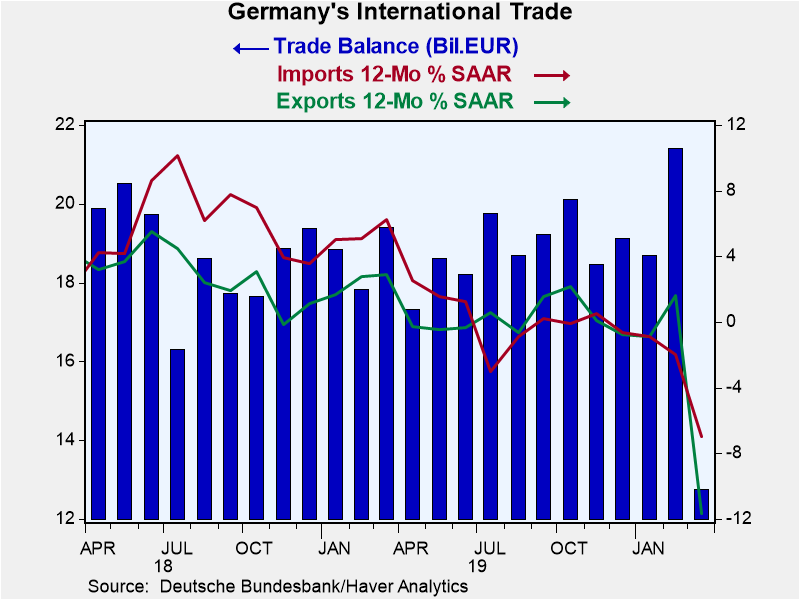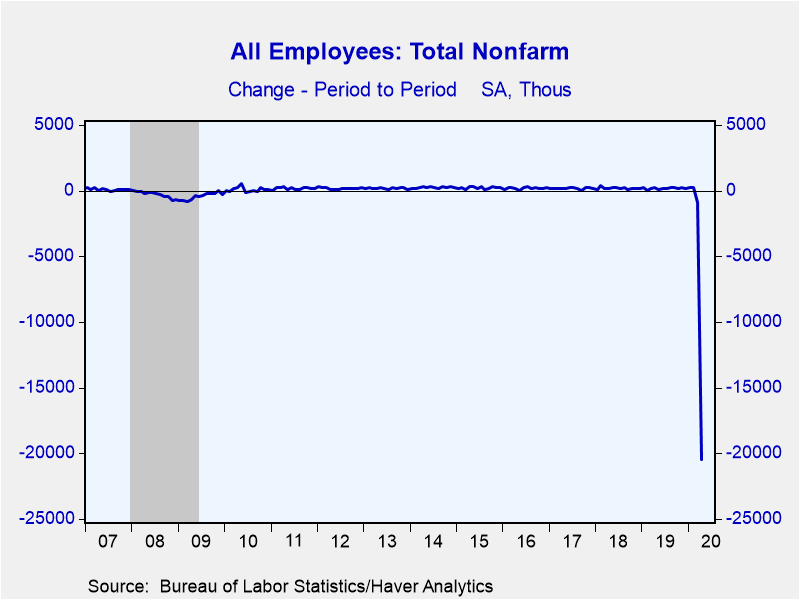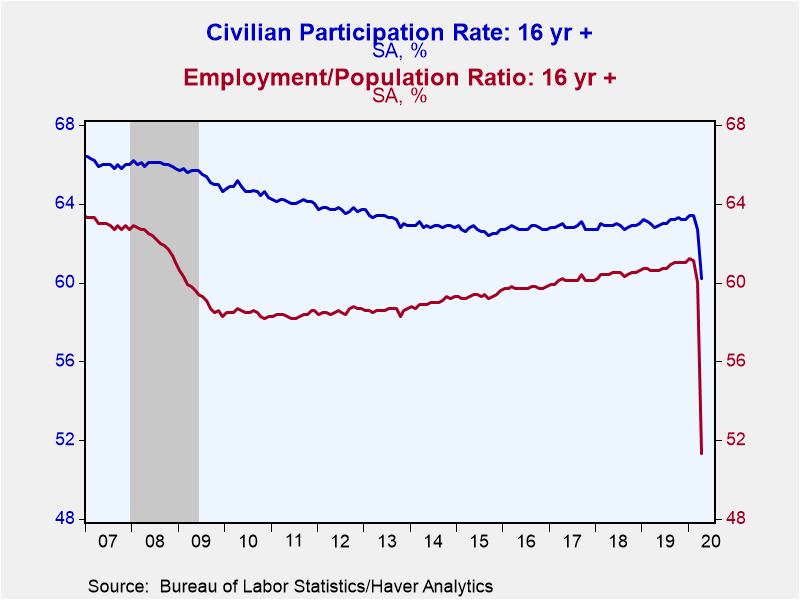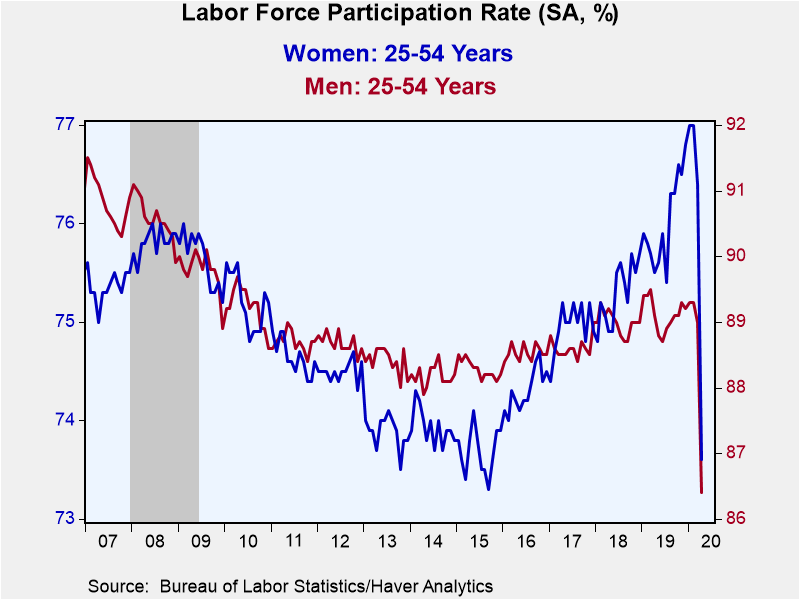 Global| May 08 2020
Global| May 08 2020U.S. Nonfarm Payroll Declines Record 20.5 Million; Unemployment Rate Sets Post-War High
by:Tom Moeller
|in:Economy in Brief
Summary
• Labor market collapses as coronavirus takes hold. • Jobless rate surges to record for monthly data reported back to 1948. • Lower paid workers bare brunt of job cuts. Nonfarm payroll employment declined a record 20.500 million [...]
• Labor market collapses as coronavirus takes hold.
• Jobless rate surges to record for monthly data reported back to 1948.
• Lower paid workers bare brunt of job cuts.
Nonfarm payroll employment declined a record 20.500 million during April (-12.9% y/y) following an 870,000 March decline, revised from -710,000. A 22.750 million fall had been expected in the Action Economics Forecast Survey. As in March, private service-producing industry employment was notably hard hit, declining 17.165 million.
The unemployment rate jumped to a monthly record 14.7%. A rise to 16.8% had been expected. Employment in the household survey weakened 22.369 million while the labor force declined 6.432 million. The overall jobless rate, including those who were marginally attached or working part-time for economic reasons, increased to 22.8%. According to National Bureau of Economic Research estimates, the last time unemployment rate stood this high occurred in October 1940.
Average hourly earnings in the private sector surged 4.7% (7.9% y/y). A 0.4% gain had been expected. The large increase reflects a disproportionate share of job loss amongst lower paid workers.
The labor market data are collected from surveys taken each month during the week containing the 12th, so these data are more than three weeks old and do not reflect more recent layoffs due to business shutdowns.
From the payroll employment survey, the 20.500 million decline reflected service sector firings which included a 7.653 million job loss in the leisure & hospitality industry as travel plans were postponed. It also reflected a 2.544 million job loss in education & health employment. Professional & business services employment declined 2.128 million and retailers shed 2.107 million jobs. Financial industry employment was reduced by 262,000 and information sector employment fell 254,000.
Manufacturing sector employment declined 1.330 million while the number of construction jobs fell 975,000. Mining & logging sector employment weakened 50,000.
The number of public sector jobs declined 980,000 as local employment fell 801,000 and state employment eased 180,000. The number of jobs worked in the federal government sector rose 1,000.
Average hourly earnings increased 4.7% as private service sector earnings rose 5.4%. It reflected a 6.8% rise in leisure & hospitality pay. Retail trade earnings gained 4.4% and financial service sector earnings rose 1.7%. Earnings in education & health services rose 1.3% and information sector earnings rose 1.2%.
 The length of the average workweek extended slightly to 34.2
hours as the private services workweek increased to 33.4 hours from 32.9. The
information sector workweek rose slightly to 36.5 hours. Finance hours held
steady at 37.6. Elsewhere in services, the number of hours shortened. Leisure
and hospitality hours were unchanged. Hours worked in mining & logging
tumbled to 43.1, the least since 2016. Factory sector hours also fell sharply to
38.3 from a high of 40.4. Hours averaged 40.9 in 2018. Construction sector hours
fell to 37.8 from a high of 39.1. The cycle high was 39.9 in January 2019.
The length of the average workweek extended slightly to 34.2
hours as the private services workweek increased to 33.4 hours from 32.9. The
information sector workweek rose slightly to 36.5 hours. Finance hours held
steady at 37.6. Elsewhere in services, the number of hours shortened. Leisure
and hospitality hours were unchanged. Hours worked in mining & logging
tumbled to 43.1, the least since 2016. Factory sector hours also fell sharply to
38.3 from a high of 40.4. Hours averaged 40.9 in 2018. Construction sector hours
fell to 37.8 from a high of 39.1. The cycle high was 39.9 in January 2019.
From the household survey, the rise in the unemployment rate to 14.7% occurred as the labor force participation rate fell sharply to 60.2%, equaling the lowest since January 1973 and down from a 2000 average of 67.1. The teenage participation rate fell sharply to 30.8%, and for those aged 20-24, it plummeted 64.5%. For workers aged 25-54, the rate dropped sharply to 79.9% from 82.7%. For men in that age bracket, the rate dropped to 86.4% from 89.0%. For women of that age, it plummeted m/m to 73.6%, and roughly equaled the annual cycle low of 73.7% during all of 2015. For workers aged 55 & over, the participation rate fell to 38.6%, but remained increased from the annual historic low of 29.4% in 1993. The employment/population ratio fell precipitously to 51.3%, down from 61.2% in January.
The average duration of unemployment fell sharply to 6.1 weeks, down from an annual high of 39.4 in 2012.
The teenage unemployment rate surged to a record 31.9%. The rate for workers aged 20-24 also reached a record 25.7%. For workers aged 25-54, the rate jumped to 12.8%, also a record. For those over 55, the jobless rate surged to 13.6% from 3.3%.
By educational attainment, unemployment of workers without a high school diploma spiked to 21.2% from 6.8%. High school graduates without a college degree were 17.3% unemployed, up from 4.4% in March. Those with some college but no degree were 15.0% without work, up from 2.8% three months earlier. College graduates were 8.4% unemployed, increased from 1.9% in February.
The labor market data are contained in Haver's USECON database. Detailed figures are in the EMPL and LABOR databases. The expectations figures are in the AS1REPNA database.
COVID-19: Which Workers Will Be Most Impacted? from the Federal Reserve Bank of Philadelphia can be found here.
| Employment: (SA, M/M Change, 000s) | Apr | Mar | Feb | Apr Y/Y | 2019 | 2018 | 2017 |
|---|---|---|---|---|---|---|---|
| Payroll Employment | -20,500 | -870 | 230 | -12.9% | 1.4% | 1.6% | 1.6% |
| Previous Estimate | -- | -701 | 275 | -- | -- | -- | -- |
| Manufacturing | -1,330 | -34 | 8 | -10.5 | 1.2 | 2.0 | 0.7 |
| Construction | -975 | -33 | 46 | -11.3 | 2.8 | 4.6 | 3.6 |
| Private Service-Producing | -17,165 | -768 | 143 | -15.3 | 1.4 | 1.5 | 1.8 |
| Government | -980 | -28 | 31 | -3.6 | 0.6 | 0.5 | 0.4 |
| Average Weekly Hours - Private Sector | 34.2 | 34.1 | 34.4 | 34.4 | 34.4 | 34.5 | 34.4 |
| Private Sector Average Hourly Earnings (%) | 4.7 | 0.5 | 0.3 | 7.9 | 3.3 | 3.0 | 2.6 |
| Unemployment Rate (%) | 14.7 | 4.4 | 3.5 | 3.6 | 3.7 | 3.9 | 4.3 |
Tom Moeller
AuthorMore in Author Profile »Prior to joining Haver Analytics in 2000, Mr. Moeller worked as the Economist at Chancellor Capital Management from 1985 to 1999. There, he developed comprehensive economic forecasts and interpreted economic data for equity and fixed income portfolio managers. Also at Chancellor, Mr. Moeller worked as an equity analyst and was responsible for researching and rating companies in the economically sensitive automobile and housing industries for investment in Chancellor’s equity portfolio. Prior to joining Chancellor, Mr. Moeller was an Economist at Citibank from 1979 to 1984. He also analyzed pricing behavior in the metals industry for the Council on Wage and Price Stability in Washington, D.C. In 1999, Mr. Moeller received the award for most accurate forecast from the Forecasters' Club of New York. From 1990 to 1992 he was President of the New York Association for Business Economists. Mr. Moeller earned an M.B.A. in Finance from Fordham University, where he graduated in 1987. He holds a Bachelor of Arts in Economics from George Washington University.










